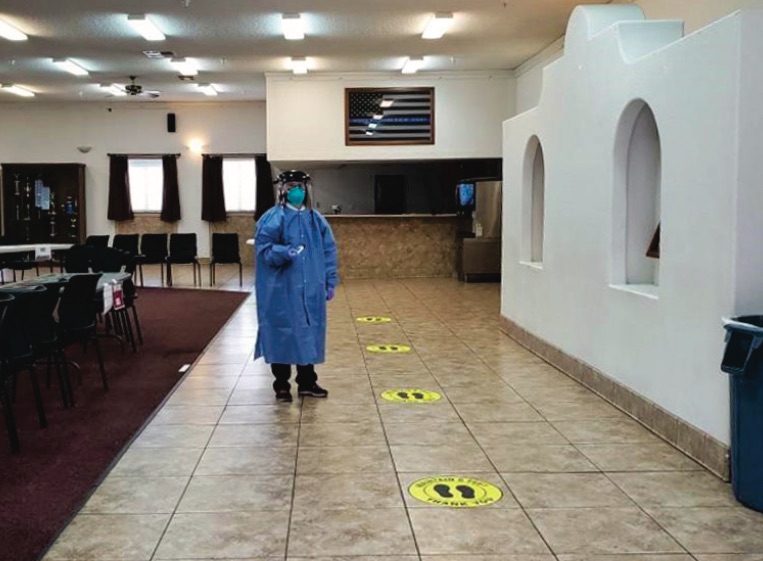Why Did Lompoc Prison Explode with COVID?
Federal Inspectors Point to Bad Policies and Poor Leadership

Staffing shortages, inadequate screenings, a scarcity of protective equipment, poor communication, and a lack of leadership all contributed to the deadly COVID-19 outbreak that swept through the federal correctional complex in Lompoc, an inspection by the Department of Justice has found.
Even before the virus was first detected in late March, the agency’s 36-page report states, medical staffing at the complex was at a mere 62 percent. That made it difficult to implement new COVID-19 protocols while also providing routine care to the institution’s 2,700 inmates. Correctional staffing was also critically short, which prevented officers from limiting their movement between the property’s multiple facilities, a key strategy in reducing transmission of the virus in a closed prison setting.
In fact, the report states, it took Lompoc officials more than two weeks to carry out an order from their superiors at the Bureau of Prisons (BOP) to begin the “compartmentalization” of staff because the complex didn’t have enough bodies to fill all its mandatory posts, including 24-hour guard duty at local hospitals where some Lompoc inmates were receiving care. By the end of April, the BOP had dispatched nine medical staff and 99 correctional officers from other prisons around the country to fill Lompoc’s ranks.
Get the top stories in your inbox by signing up for our daily newsletter, Indy Today.
Staff screenings were dangerously deficient at times, the Department of Justice (DOJ) also found. “Specifically, we identified two staff members who came to work in late March after experiencing COVID-19 symptoms, but their symptoms were not detected in the screening process.” Responding to a confidential survey conducted by the DOJ as part of its inspection, multiple Lompoc staff raised concerns that nonmedical employees had been administering the screenings, which often failed to look for symptoms other than fever.
Detection among inmates was problematic, as well. “We found that Lompoc did not seek to test an inmate who, according to Lompoc medical records, informed staff on March 22 that he had begun to experience several different physical symptoms, including nausea, vomiting, and reported general malaise and a dry cough over the prior 2 days,” the report says. “Both vomiting and cough were known symptoms of COVID-19 at that time.” The inmate was finally admitted to the hospital on March 26. By that time, the virus was starting to take hold across multiple units in the prison, ultimately infecting more than 1,000 inmates and staff. Four inmates died from the virus, and others suffered debilitating medical complications. At one point, the complex had one of the highest infection rates in the entire federal prison system.
While Lompoc officials have insisted that ample supplies of personal protective equipment (PPE) have always been available to both staff and inmates, 70 percent of prison staff who responded to the DOJ survey in late April said additional PPE for staff was an “immediate need”; 46 percent said inmates needed more PPE, as well. Similarly, while Lompoc managers claimed in statements to DOJ inspectors that the prison was well-stocked with hygiene items, such as soap and hand sanitizer, 55 percent of staff said offering more for employees was another “immediate need”; 36 percent said the same for inmates.
A vacuum of leadership at Lompoc also likely contributed to the severity of the outbreak, as the complex “did not have communications protocols in place to fully inform staff about the spread of the virus,” the report states. Lompoc cycled through three different wardens during the emergency, and most of its management positions were filled with either temporary duty staff from other prisons or local staff working in an “acting” capacity.
“In addition,” the DOJ said, “a union official reported to us that during the early stages of the outbreak the institution did not inform staff members that they had been in close contact with a colleague who had tested positive for COVID-19. This failure to inform staff members of their contact with an infected person meant that BOP staff who had possibly been exposed to the virus — and therefore could themselves have been infected — were potentially exposing colleagues, inmates, and family members.”
Perhaps the most damning section of the report focuses on Lompoc’s resistance to a March 26 order from Attorney General William Barr to prioritize the use of home confinement for the dual purposes of protecting medically at-risk, nonviolent inmates and thinning the overall prison population to allow for better social distancing. The DOJ called Lompoc’s use of the new policy, enacted under the CARES Act, “extremely limited.” Inspectors found in May that of the 509 Lompoc inmates eligible for home confinement, only 34 had been transferred out of the prison.
One of the complex’s acting wardens had attempted to argue to inspectors that additional transfers would threaten public safety. The inspectors acknowledged the complexity of the issue — “These are difficult, risk-based decisions,” they said — but then stated firmly that by early April, at a time when Lompoc was facing a growing COVID-19 crisis, “the Attorney General had directed the BOP to ‘immediately maximize appropriate transfers to home confinement of all appropriate inmates’ at prisons, like Lompoc, ‘where COVID-19 is materially affecting operations.’ Despite this admonition, the data does not reflect that the BOP took immediate action at Lompoc.”
At the Santa Barbara Independent, our staff is working around the clock to cover every aspect of this crisis — sorting truth from rumor. Our reporters and editors are asking the tough questions of our public health officials and spreading the word about how we can all help one another. The community needs us — now more than ever — and we need you in order to keep doing the important work we do. Support the Independent by making a direct contribution or with a subscription to Indy+.



